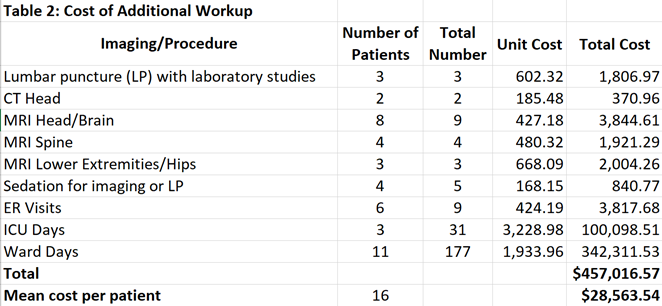Hospital Medicine: Clinical
Hospital Medicine 2
761 - Failure to Recognize Scurvy as Cause of Musculoskeletal Complaints Leads to Increased Hospital Costs
Publication Number: 761.12

Stephanie P. Gilley, MD, PhD (she/her/hers)
Assistant Professor
University of Colorado School of Medicine
Aurora, Colorado, United States
Presenting Author(s)
Background: Vitamin C deficiency in children commonly presents with musculoskeletal (MSK) complaints such as gait disturbances, refusal to bear weight, and joint or bone pain. Failure to include scurvy in the initial differential diagnosis can lead to costly and invasive workups including hospitalization and advanced diagnostic procedures to rule out inflammatory, infectious, autoimmune, and oncologic conditions with clinical overlap.
Objective:
Determine healthcare costs of delayed vitamin C deficiency diagnosis.
Design/Methods: We conducted a retrospective chart review of patients seen in a quaternary care pediatric hospital over age 1 year with ICD9/10 codes for vitamin C deficiency, ascorbic acid deficiency or scurvy from 2003-2022. The medical records of each patient were reviewed to identify presenting symptoms, past medical history, dietary information, ascorbic acid level, imaging, other diagnostic workup, and provider notes. The Pediatric Health Information System (PHIS) was used to estimate cost over that of a standard workup for gait disturbance: CBC with differential, inflammatory markers, x-rays, and ascorbic acid level (Table 1).
Results: A total of 49 patients were identified with a diagnosis of scurvy, 19 of whom had MSK complaints at the time of diagnosis. Three patients were excluded from cost analysis as MSK symptoms were ultimately attributed to other causes. Of the 16 remaining patients, 4 were female, 9 had autism, 3 had severe malnutrition, and 2 had obesity. Age at scurvy diagnosis ranged from 2-18 years (mean 8.4 years), with mean symptom onset 9.6 weeks prior to diagnosis (median 2.5 weeks). Two patients had cardiac arrest as a sequela of scurvy during anesthesia induction for diagnostic procedures and required prolonged hospitalization. Total excess cost was $457,017 for an average of $28,564 per patient (Table 2). This cost estimate does not account for other lower cost studies or procedures, caregiver expenses (lost wages, parking, meals at the hospital, etc), or outpatient visits to primary care or subspecialists.
Conclusion(s):
Pediatric scurvy is not absent from modern medicine and diagnosis is often delayed. Our study highlights scurvy as an important inclusion to the differential diagnosis for limp, MSK pain, and/or refusal to bear weight in patients with food selectivity. Increased awareness of scurvy and its signs and symptoms in children may reduce severe disease, adverse effects related to unnecessary tests/treatment, and facilitate high-value care.
.png)
